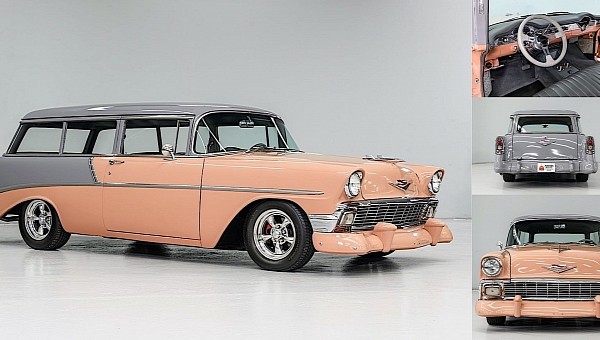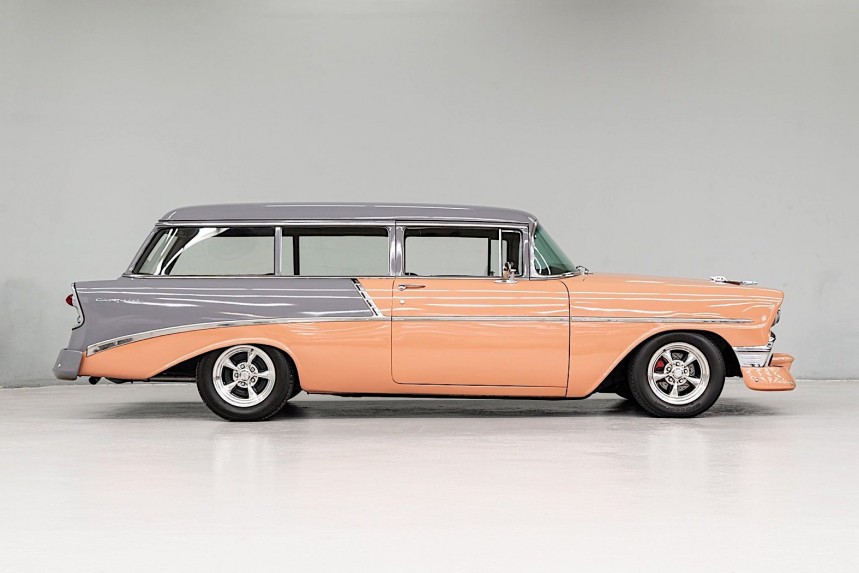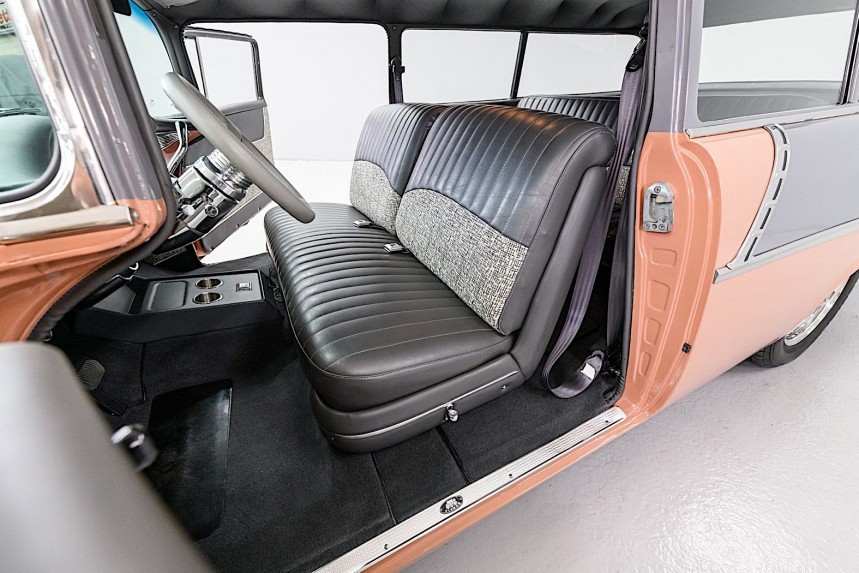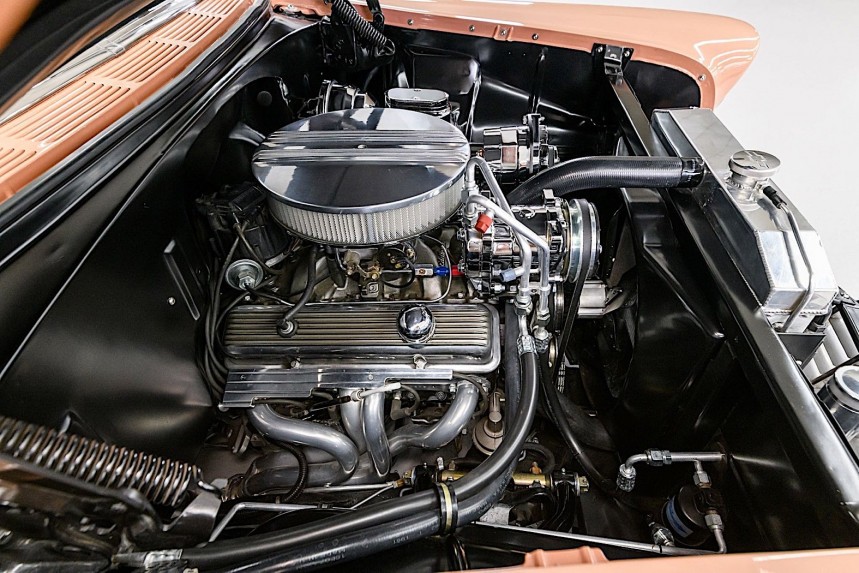Ah, two-door station wagons… Vehicles so strange in appearance that there’s no middle ground with them: you either hate or love them. I’m part of the latter group, feeling sorry that machines such as the Chevrolet 210 Handyman are no longer among us in the proper sense, rolling off assembly lines, but always happy to see the custom industry is more than willing to fill that void.
Officially, the first car designed like this, with the front half as if taken from a coupe and the rear belonging to a cargo hauler, was the 1946 Willys Jeep Station Wagon (technically, it was even weirder, as it was also an SUV of sorts). Few people, however, remember this one as a proper representative of the breed.
Instead, each time the term two-door wagon is used in a sentence, images of cars made by two of America’s most notorious car companies, General Motors and Ford, will always pop to mind. You know, names like the Chevrolet Nomad or the Ford Ranch Wagon. But it was another model altogether that truly gave birth to this genre.
Back in 1953, in a time considered by some the golden era of American car design, Chevrolet birthed something called the 210. It came as a successor to the war-era Deluxe and quickly became one of the pillars of the series of Chevy models that would come to be known as the Tri-Five.
Like many cars of its era, the 210 (alternatively spelled Two-Ten) came in a variety of body styles, ranging from the standard four-door sedan and going as nuts as a two-door convertible. The wackiest incarnation of the model had to have been the two-door station wagon.
They didn’t call it that back then, of course. The term used to describe the 210 wagon was Handyman, with the name making no secret as to what population group the vehicle targeted. It came out from the very first year, 1953, but was at first offered as a four-door wagon. Then, in 1955, two of the doors were dropped, giving birth to a style that would briefly become extremely popular.
When the 210 died out in 1957 to make room for the Biscayne, the Handyman died with it. But it didn’t stay dead, as our modern society, the biggest sucker for 1950s and 1960s cars, brought it back in various shapes, sizes, and colors, in a bid to satisfy the needs of an ever-increasing fanbase.
Compared to other 210s, the Handyman is somewhat rare though, so when one somehow crosses our path, we just have to have a closer look. We did when we came across this example here, and found it worthy of its fifteen minutes of fame.
The wagon is a 1956 Handyman, restored to its former glory (and then some) in 2012, with extra work being conducted on the interior in 2019. It’s not an extreme project in terms of how different it is from stock, but packs just enough new gear and changes to make it more than interesting.
We’ll start, as usual, from the outside, where the two-tone, classic 1950s body greets us. The two paints used were popular choices back when the car was originally made, Coral and Dawn Grey. Now, taken separately, they might have come across as a little dull, but when used in this combination, the effect is simply mesmerizing.
Add to that all the minor, yet important touches such a car must have, and you get the complete package: look out for the jet hood ornament (the car was born, after all, during the Jet Age), the chrome elements shining away here and there, and the bumpers in the color of the body, different front and rear.
The car no longer rides on its stock wheels, but the American Racing bits now fitted onto it do seem like they belong there. All four come with a diameter of 15 inches and wrapped in BFGoodrich radial tires.
The interior is far from extravagant, but does come across as the perfect blend between charcoal vinyl (unclear if that’s leather) and grey fabric, especially thanks to the same design motif extending from the seats to the door panels and all the way to the two pillows provided for the rear bench.
The dashboard is the one tasked with making the visual connection with the exterior, its lower part painted Coral and the upper one grey. Somewhere in between, a set of custom analog gauges can be seen, but also an old-school AM/FM stereo.
The gauges are there to tell the driver what and how the Handyman is doing, but it’s under the hood where we find the hardware actually doing something. That would be the 350ci small-block engine of unknown power and tied to a 4-speed automatic transmission.
When it’s on, it allows the car to move on a front coil and rear leaf suspension system. It can be told where to go by means of power steering, while stopping power is supplied by non-descript disc and drum brakes with ceramic pads.
The 1956 Chevrolet Handyman 210 Wagon shows just 4,900 miles (7,900 km) on the clock since work on it was completed, meaning it was most likely very well cared for. You can find it in North Carolina on the lot of a dealer called Auto Barn Classic Cars, which has it listed with a price tag reading $52,995.
And I know this is like comparing apples to oranges, but just for the sake of it, that’s more than the price of a brand new, all-wheel drive Dodge Durango R/T SUV.
Instead, each time the term two-door wagon is used in a sentence, images of cars made by two of America’s most notorious car companies, General Motors and Ford, will always pop to mind. You know, names like the Chevrolet Nomad or the Ford Ranch Wagon. But it was another model altogether that truly gave birth to this genre.
Back in 1953, in a time considered by some the golden era of American car design, Chevrolet birthed something called the 210. It came as a successor to the war-era Deluxe and quickly became one of the pillars of the series of Chevy models that would come to be known as the Tri-Five.
Like many cars of its era, the 210 (alternatively spelled Two-Ten) came in a variety of body styles, ranging from the standard four-door sedan and going as nuts as a two-door convertible. The wackiest incarnation of the model had to have been the two-door station wagon.
When the 210 died out in 1957 to make room for the Biscayne, the Handyman died with it. But it didn’t stay dead, as our modern society, the biggest sucker for 1950s and 1960s cars, brought it back in various shapes, sizes, and colors, in a bid to satisfy the needs of an ever-increasing fanbase.
Compared to other 210s, the Handyman is somewhat rare though, so when one somehow crosses our path, we just have to have a closer look. We did when we came across this example here, and found it worthy of its fifteen minutes of fame.
The wagon is a 1956 Handyman, restored to its former glory (and then some) in 2012, with extra work being conducted on the interior in 2019. It’s not an extreme project in terms of how different it is from stock, but packs just enough new gear and changes to make it more than interesting.
Add to that all the minor, yet important touches such a car must have, and you get the complete package: look out for the jet hood ornament (the car was born, after all, during the Jet Age), the chrome elements shining away here and there, and the bumpers in the color of the body, different front and rear.
The car no longer rides on its stock wheels, but the American Racing bits now fitted onto it do seem like they belong there. All four come with a diameter of 15 inches and wrapped in BFGoodrich radial tires.
The interior is far from extravagant, but does come across as the perfect blend between charcoal vinyl (unclear if that’s leather) and grey fabric, especially thanks to the same design motif extending from the seats to the door panels and all the way to the two pillows provided for the rear bench.
The gauges are there to tell the driver what and how the Handyman is doing, but it’s under the hood where we find the hardware actually doing something. That would be the 350ci small-block engine of unknown power and tied to a 4-speed automatic transmission.
When it’s on, it allows the car to move on a front coil and rear leaf suspension system. It can be told where to go by means of power steering, while stopping power is supplied by non-descript disc and drum brakes with ceramic pads.
The 1956 Chevrolet Handyman 210 Wagon shows just 4,900 miles (7,900 km) on the clock since work on it was completed, meaning it was most likely very well cared for. You can find it in North Carolina on the lot of a dealer called Auto Barn Classic Cars, which has it listed with a price tag reading $52,995.
And I know this is like comparing apples to oranges, but just for the sake of it, that’s more than the price of a brand new, all-wheel drive Dodge Durango R/T SUV.

































